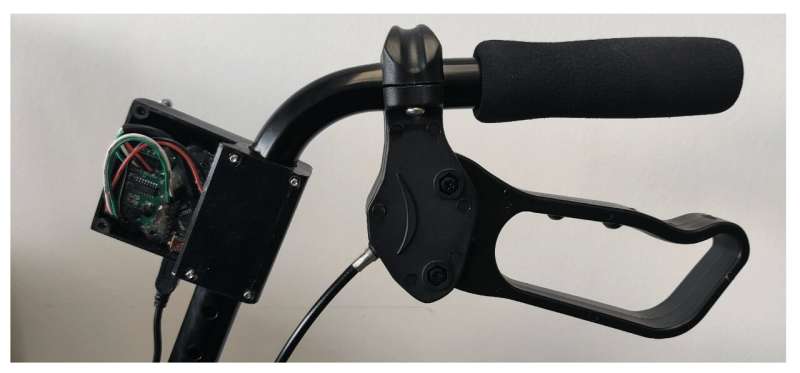Development of a low-cost, 'smart' rollator for clinical rehabilitation

Researchers from the University of Malaga have designed a new system that analyzes the evolution of patients undergoing treatment. Specifically, it allows for accurate progress data while the patient performs other activities. The frame is cheaper than others on the market, and its functionalities can be extended with addons adapted to each person's individual needs.
The researchers from the University of Malaga in collaboration with the Polytechnic University of Catalonia have created an "intelligent" rollator that evaluates patient movements to improve rehabilitation. With this system based on a standard model called Walk-IT, professionals receive better information about the progress of patients under treatment, allowing them to attend to a greater number of users with more accurate assessments.
During rehabilitation treatments, therapists have to evaluate a variety of information related to progress during the exercises that patients are required to perform, such as whether they manage to improve walking speed, whether the gait is symmetrical or whether there is partial weight bearing.
So far, this information has been taken manually by professionals, which requires direct observation of their movements. Although rollators with factory-installed modules are available, they are too expensive for mass deployment in all clinics. In addition, the incorporation of more components increases their weight, which affects the gait pattern and alters the actual gait results.
With traditional systems, therapists can only assess the progress of one person at a time. However, the Walk-IT model, as the experts have called it, allows the exercises to be performed at the same time as the data are automatically recorded and evaluated for later consultation. This reduces the attention needed from professionals, as they do not have to spend time collecting that relevant information during the course of treatment. This novel system is described in the article "Walk-IT: An Open-Source Modular Low-Cost Smart Rollator," published in the journal Sensors.
In addition, both the physical designs included (the hardware) and the programs used (the software) are licensed open-source, which reduces the cost considerably and allows its widespread implementation. The system is available for consultation and download at github.com/TaISLab/WalKit.
Rollators that monitor movement are scarce on the market today, they are custom-made and range in price from 3,000 to 9,000 euros, depending on the modules they include. "The possibility of adding new observation elements to a standard rollator using low-cost devices and free software makes it an ideal option for use in any rehabilitation clinic and reduces the price to around 500 euros," Fundación Descubre was told by Joaquín Ballesteros, one of the authors of the article.
In addition to a control system, the researchers have added other devices to the conventional rollator. Firstly, they attached load gauges to the handles to measure the support exerted on each handle during walking. Encoders are also included on the rear wheels of the rollator to measure user speed and estimate stride length. Finally, they have placed a laser sensor that detects feet movement, gait phases or whether there are any nearby obstacles.
Improving step by step
Until now, a model has been used that is owned by the Polytechnic University of Barcelona and that could not be modified. In other words, the hardware was installed in the factory and could not be extended or adapted. The experts thus detected the need to create a system that could be modulated according to the needs of each individual and that was totally unrestricted with the aim of reducing costs and giving it a direct application.
In this way, the researchers started from a rollator commonly used in rehabilitation clinics which does not require any modification, and added modules that measure different parameters needed to monitor patients, such as cadence, step velocity or time, and stride length. In addition, the system can directly measure rollator position, speed and applied forces.
The experts have confirmed that the data obtained from 11 patients undergoing treatment match and even improve the accuracy of those collected by therapists using the traditional method. The only drawback encountered is that visibility of the patient's legs is required for an adequate observation by the laser, since when wearing long skirts, for example, the data are not captured appropriately.
The researchers intend to continue the trials with the aim of offering more benefits to institutions interested in implementing it in society in an efficient way. In particular, they propose research with different types of disabilities in hospitals and nursing homes to validate their results and adjust them for application in more cases.
More information: Manuel Fernandez-Carmona et al, Walk-IT: An Open-Source Modular Low-Cost Smart Rollator, Sensors (2022). DOI: 10.3390/s22062086



















